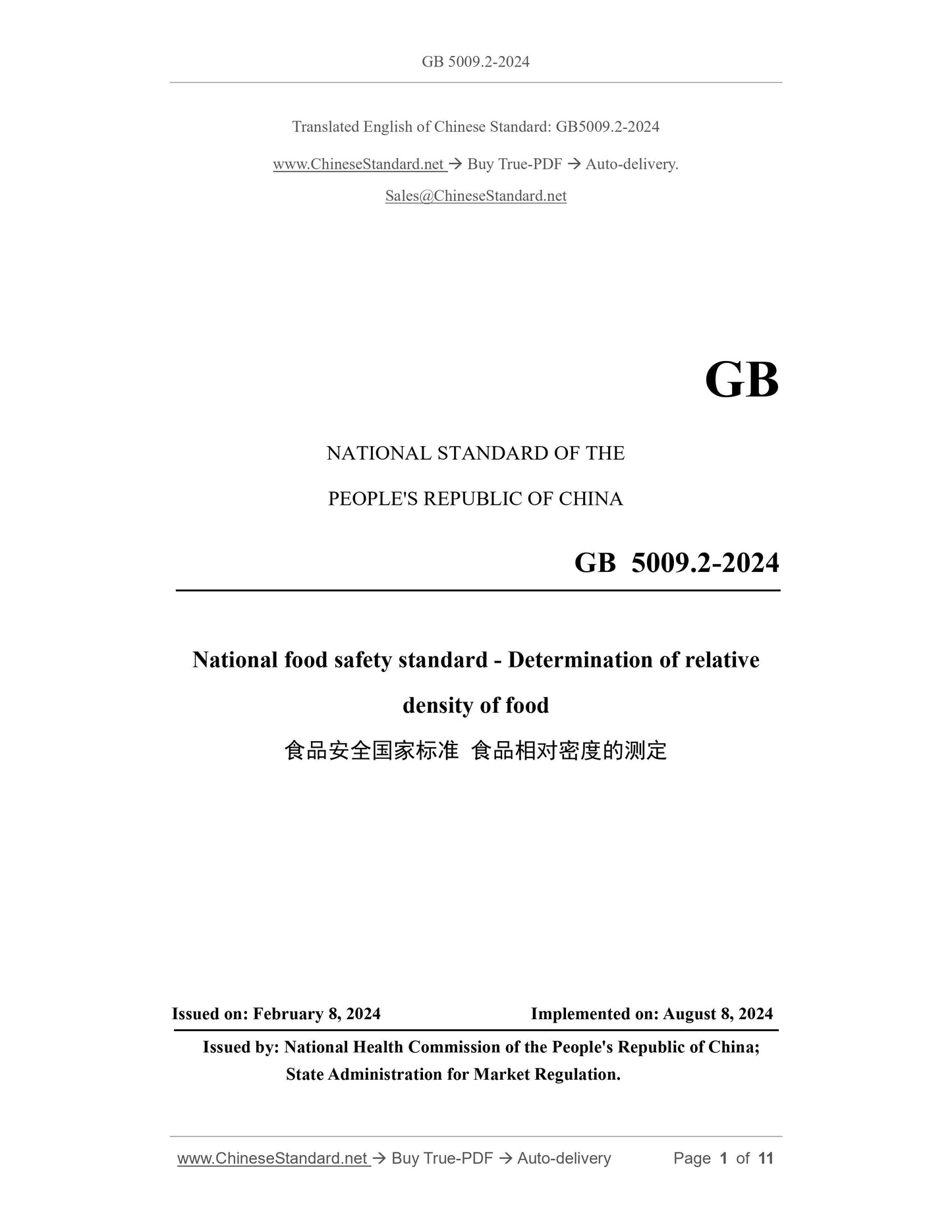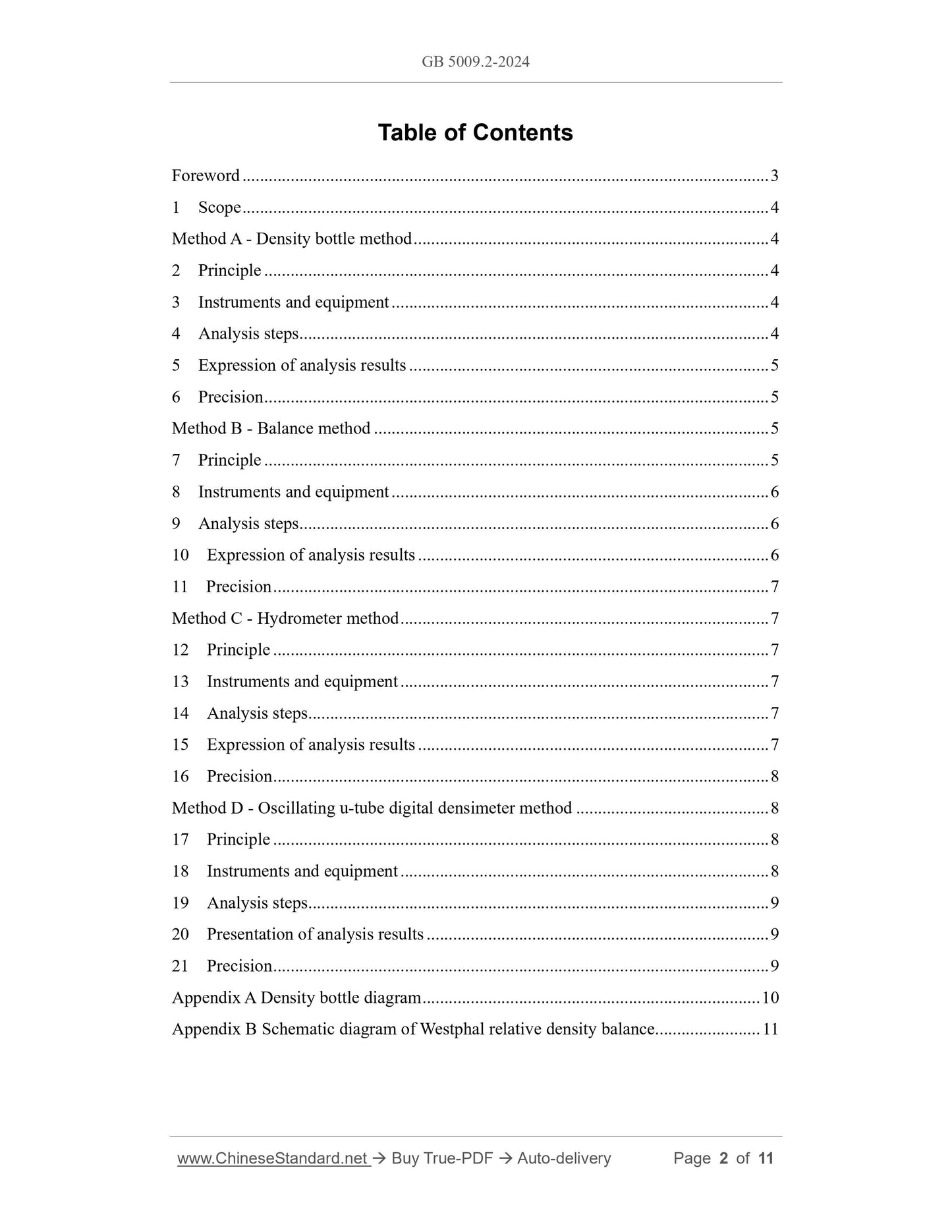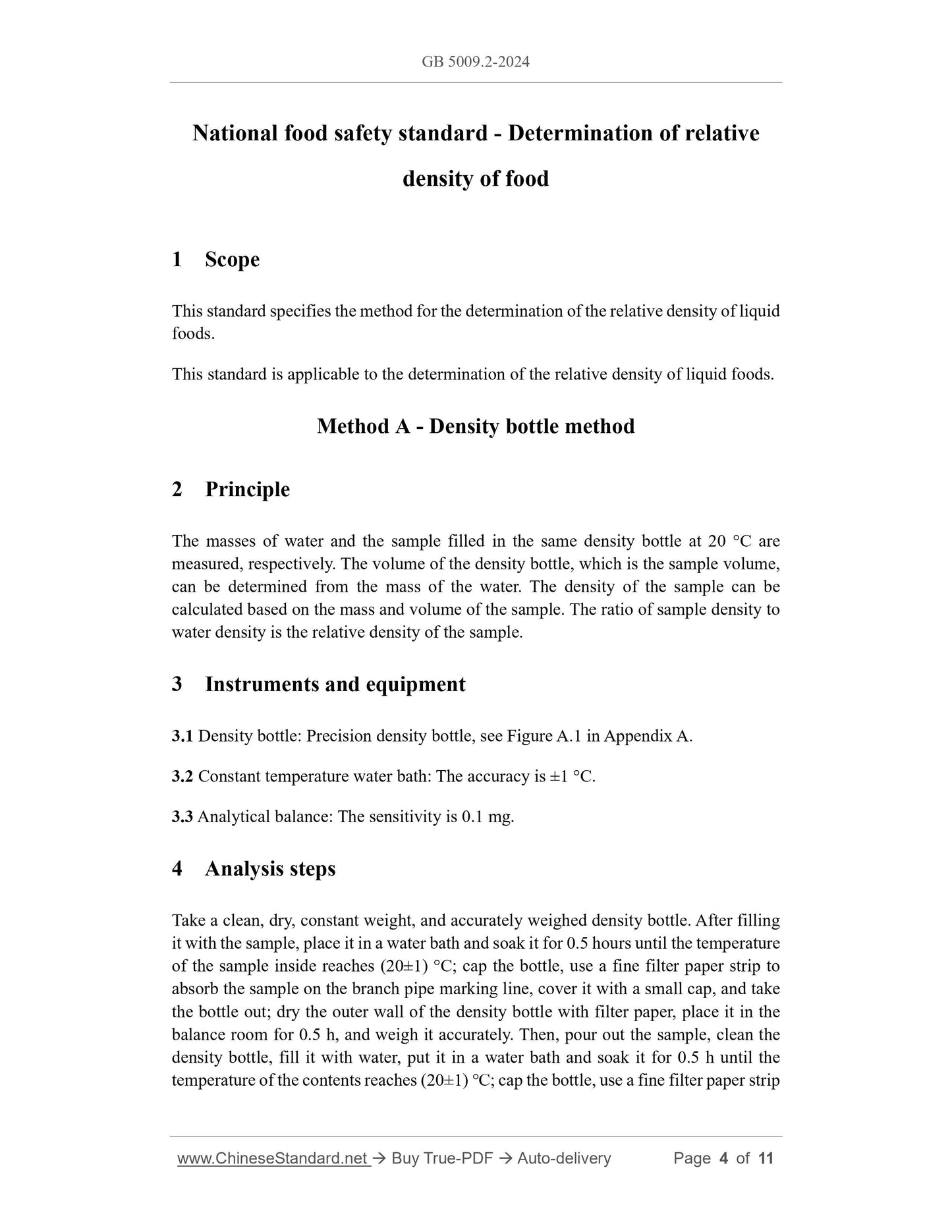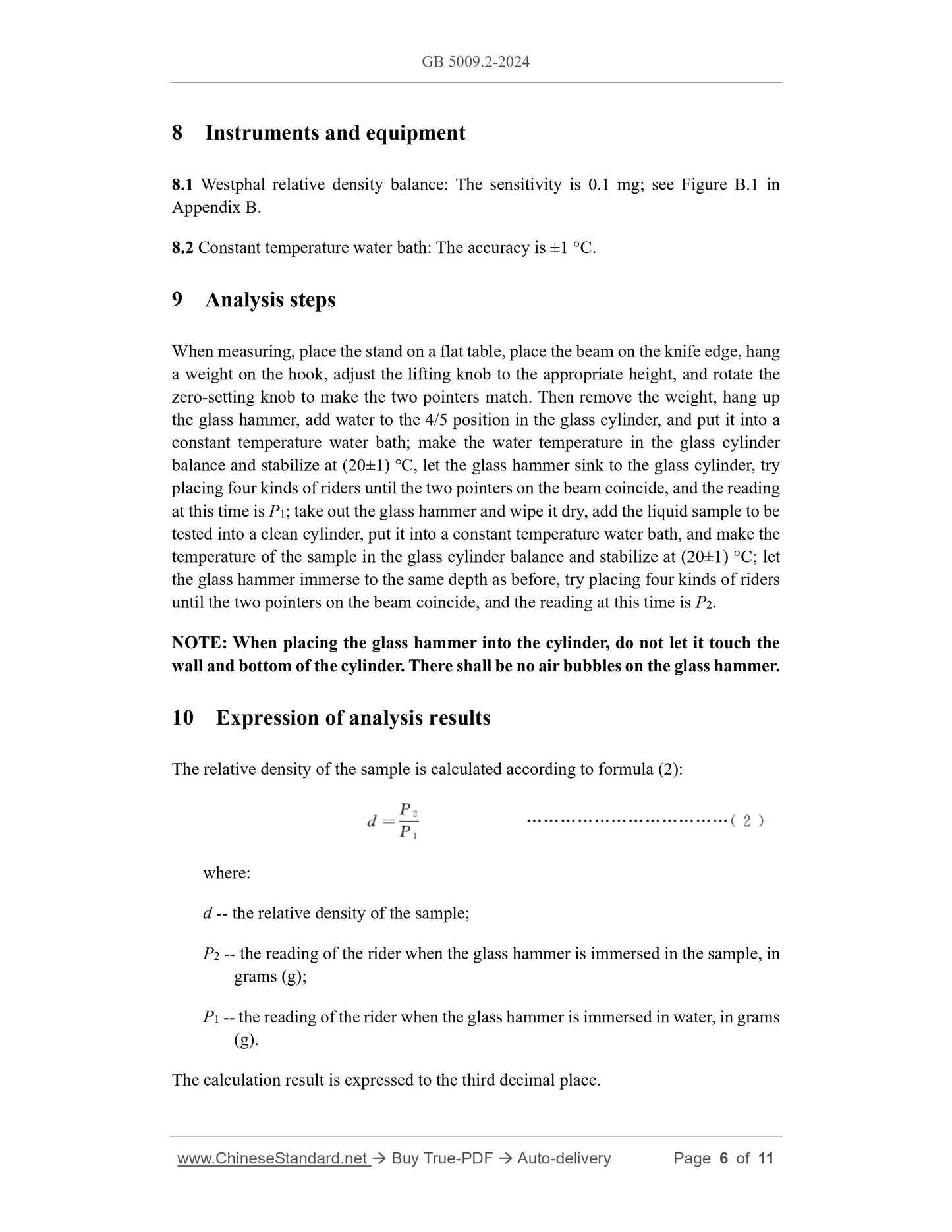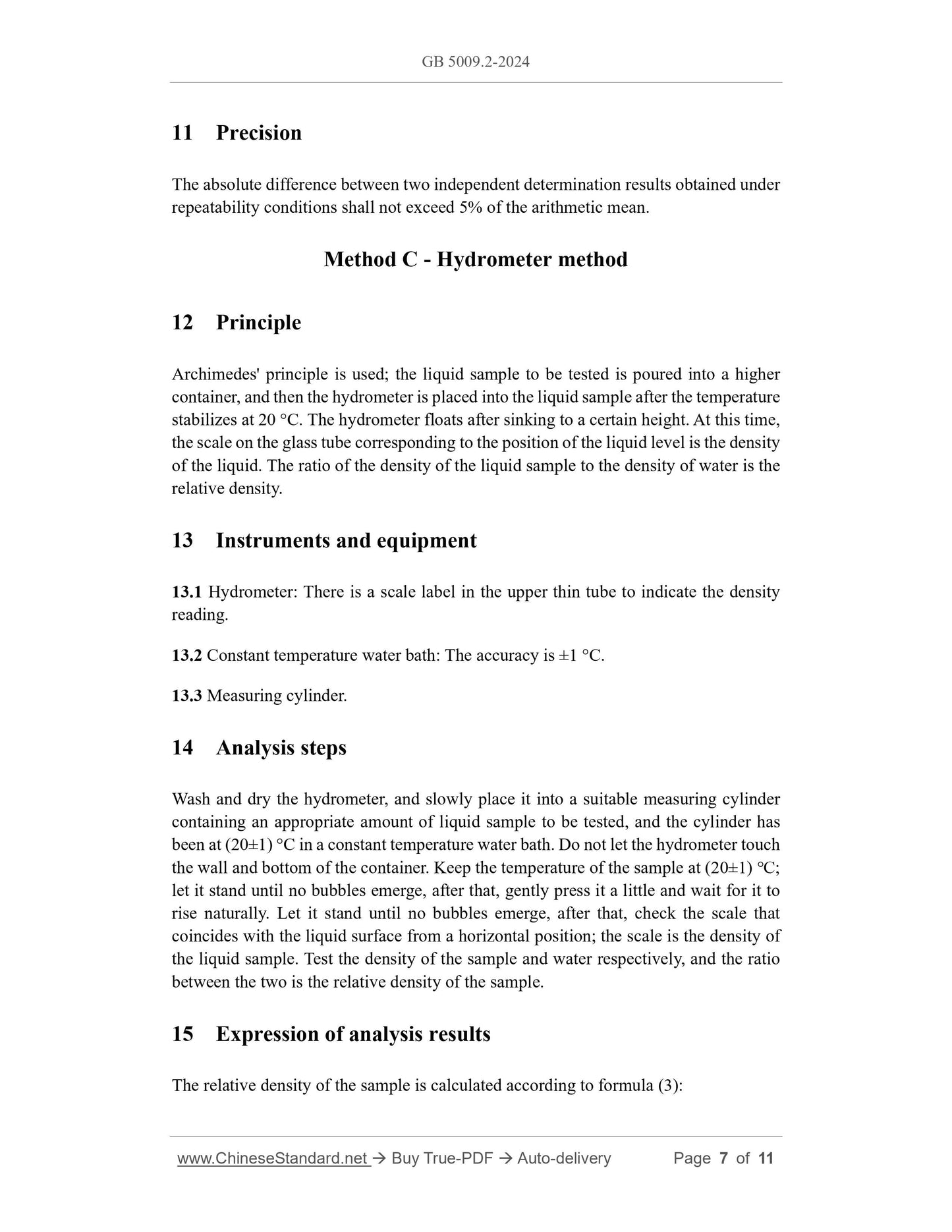1
/
of
5
PayPal, credit cards. Download editable-PDF and invoice in 1 second!
GB 5009.2-2024 English PDF (GB5009.2-2024)
GB 5009.2-2024 English PDF (GB5009.2-2024)
Regular price
$140.00 USD
Regular price
Sale price
$140.00 USD
Unit price
/
per
Shipping calculated at checkout.
Couldn't load pickup availability
Delivery: 3 seconds. Download true-PDF + Invoice.
Get QUOTATION in 1-minute: Click GB 5009.2-2024
Historical versions: GB 5009.2-2024
Preview True-PDF (Reload/Scroll if blank)
GB 5009.2-2024: National food safety standards--Determination of relative density of food
GB 5009.2-2024
GB
NATIONAL STANDARD OF THE
PEOPLE'S REPUBLIC OF CHINA
National food safety standard - Determination of relative
density of food
ISSUED ON: FEBRUARY 8, 2024
IMPLEMENTED ON: AUGUST 8, 2024
Issued by: National Health Commission of the People's Republic of China;
State Administration for Market Regulation.
Table of Contents
Foreword ... 3
1 Scope ... 4
Method A - Density bottle method ... 4
2 Principle ... 4
3 Instruments and equipment ... 4
4 Analysis steps ... 4
5 Expression of analysis results ... 5
6 Precision ... 5
Method B - Balance method ... 5
7 Principle ... 5
8 Instruments and equipment ... 6
9 Analysis steps ... 6
10 Expression of analysis results ... 6
11 Precision ... 7
Method C - Hydrometer method ... 7
12 Principle ... 7
13 Instruments and equipment ... 7
14 Analysis steps ... 7
15 Expression of analysis results ... 7
16 Precision ... 8
Method D - Oscillating u-tube digital densimeter method ... 8
17 Principle ... 8
18 Instruments and equipment ... 8
19 Analysis steps ... 9
20 Presentation of analysis results ... 9
21 Precision ... 9
Appendix A Density bottle diagram ... 10
Appendix B Schematic diagram of Westphal relative density balance ... 11
National food safety standard - Determination of relative
density of food
1 Scope
This standard specifies the method for the determination of the relative density of liquid
foods.
This standard is applicable to the determination of the relative density of liquid foods.
Method A - Density bottle method
2 Principle
The masses of water and the sample filled in the same density bottle at 20 °C are
measured, respectively. The volume of the density bottle, which is the sample volume,
can be determined from the mass of the water. The density of the sample can be
calculated based on the mass and volume of the sample. The ratio of sample density to
water density is the relative density of the sample.
3 Instruments and equipment
3.1 Density bottle: Precision density bottle, see Figure A.1 in Appendix A.
3.2 Constant temperature water bath: The accuracy is ±1 °C.
3.3 Analytical balance: The sensitivity is 0.1 mg.
4 Analysis steps
Take a clean, dry, constant weight, and accurately weighed density bottle. After filling
it with the sample, place it in a water bath and soak it for 0.5 hours until the temperature
of the sample inside reaches (20±1) °C; cap the bottle, use a fine filter paper strip to
absorb the sample on the branch pipe marking line, cover it with a small cap, and take
the bottle out; dry the outer wall of the density bottle with filter paper, place it in the
balance room for 0.5 h, and weigh it accurately. Then, pour out the sample, clean the
density bottle, fill it with water, put it in a water bath and soak it for 0.5 h until the
temperature of the contents reaches (20±1) ℃; cap the bottle, use a fine filter paper strip
8 Instruments and equipment
8.1 Westphal relative density balance: The sensitivity is 0.1 mg; see Figure B.1 in
Appendix B.
8.2 Constant temperature water bath: The accuracy is ±1 °C.
9 Analysis steps
When measuring, place the stand on a flat table, place the beam on the knife edge, hang
a weight on the hook, adjust the lifting knob to the appropriate height, and rotate the
zero-setting knob to make the two pointers match. Then remove the weight, hang up
the glass hammer, add water to the 4/5 position in the glass cylinder, and put it into a
constant temperature water bath; make the water temperature in the glass cylinder
balance and stabilize at (20±1) ℃, let the glass hammer sink to the glass cylinder, try
placing four kinds of riders until the two pointers on the beam coincide, and the reading
at this time is P1; take out the glass hammer and wipe it dry, add the liquid sample to be
tested into a clean cylinder, put it into a constant temperature water bath, and make the
temperature of the sample in the glass cylinder balance and stabilize at (20±1) °C; let
the glass hammer immerse to the same depth as before, try placing four kinds of riders
until the two pointers on the beam coincide, and the reading at this time is P2.
NOTE: When placing the glass hammer into the cylinder, do not let it touch the
wall and bottom of the cylinder. There shall be no air bubbles on the glass hammer.
10 Expression of analysis results
The relative density of the sample is calculated according to formula (2):
where:
d -- the relative density of the sample;
P2 -- the reading of the rider when the glass hammer is immersed in the sample, in
grams (g);
P1 -- the reading of the rider when the glass hammer is immersed in water, in grams
(g).
The calculation result is expressed to the third decimal place.
11 Precision
The absolute difference between two independent determination results obtained under
repeatability conditions shall not exceed 5% of the arithmetic mean.
Method C - Hydrometer method
12 Principle
Archimedes' principle is used; the liquid sample to be tested is poured into a higher
container, and then the hydrometer is placed into the liquid sample after the temperature
stabilizes at 20 °C. The hydrometer floats after sinking to a certain height. At this time,
the scale on the glass tube corresponding to the position of the liquid level is the density
of the liquid. The ratio of the density of the liquid sample to the density of water is the
relative density.
13 Instruments and equipment
13.1 Hydrometer: There is a scale label in the upper thin tube to indicate the density
reading.
13.2 Constant temperature water bath: The accuracy is ±1 °C.
13.3 Measuring cylinder.
14 Analysis steps
Wash and dry the hydrometer, and slowly place it into a suitable measuring cylinder
containing an appropriate amount of liquid sample to be tested, and the cylinder has
been at (20±1) °C in a constant temperature water bath. Do not let the hydrometer touch
the wall and bottom of the container. Keep the temperature of the sample at (20±1) ℃;
let it stand until no bubbles emerge, after that, gently press it a little and wait for it to
rise naturally. Let it stand until no bubbles emerge, after that, check the scale that
coincides with the liquid surface from a horizontal position; the scale is the density of
the liquid sample. Test the density of the sample and water respectively, and the ratio
between the two is the relative density of the sample.
15 Expression of analysis results
The relative density of the sample is calculated according to formula (3):
Get QUOTATION in 1-minute: Click GB 5009.2-2024
Historical versions: GB 5009.2-2024
Preview True-PDF (Reload/Scroll if blank)
GB 5009.2-2024: National food safety standards--Determination of relative density of food
GB 5009.2-2024
GB
NATIONAL STANDARD OF THE
PEOPLE'S REPUBLIC OF CHINA
National food safety standard - Determination of relative
density of food
ISSUED ON: FEBRUARY 8, 2024
IMPLEMENTED ON: AUGUST 8, 2024
Issued by: National Health Commission of the People's Republic of China;
State Administration for Market Regulation.
Table of Contents
Foreword ... 3
1 Scope ... 4
Method A - Density bottle method ... 4
2 Principle ... 4
3 Instruments and equipment ... 4
4 Analysis steps ... 4
5 Expression of analysis results ... 5
6 Precision ... 5
Method B - Balance method ... 5
7 Principle ... 5
8 Instruments and equipment ... 6
9 Analysis steps ... 6
10 Expression of analysis results ... 6
11 Precision ... 7
Method C - Hydrometer method ... 7
12 Principle ... 7
13 Instruments and equipment ... 7
14 Analysis steps ... 7
15 Expression of analysis results ... 7
16 Precision ... 8
Method D - Oscillating u-tube digital densimeter method ... 8
17 Principle ... 8
18 Instruments and equipment ... 8
19 Analysis steps ... 9
20 Presentation of analysis results ... 9
21 Precision ... 9
Appendix A Density bottle diagram ... 10
Appendix B Schematic diagram of Westphal relative density balance ... 11
National food safety standard - Determination of relative
density of food
1 Scope
This standard specifies the method for the determination of the relative density of liquid
foods.
This standard is applicable to the determination of the relative density of liquid foods.
Method A - Density bottle method
2 Principle
The masses of water and the sample filled in the same density bottle at 20 °C are
measured, respectively. The volume of the density bottle, which is the sample volume,
can be determined from the mass of the water. The density of the sample can be
calculated based on the mass and volume of the sample. The ratio of sample density to
water density is the relative density of the sample.
3 Instruments and equipment
3.1 Density bottle: Precision density bottle, see Figure A.1 in Appendix A.
3.2 Constant temperature water bath: The accuracy is ±1 °C.
3.3 Analytical balance: The sensitivity is 0.1 mg.
4 Analysis steps
Take a clean, dry, constant weight, and accurately weighed density bottle. After filling
it with the sample, place it in a water bath and soak it for 0.5 hours until the temperature
of the sample inside reaches (20±1) °C; cap the bottle, use a fine filter paper strip to
absorb the sample on the branch pipe marking line, cover it with a small cap, and take
the bottle out; dry the outer wall of the density bottle with filter paper, place it in the
balance room for 0.5 h, and weigh it accurately. Then, pour out the sample, clean the
density bottle, fill it with water, put it in a water bath and soak it for 0.5 h until the
temperature of the contents reaches (20±1) ℃; cap the bottle, use a fine filter paper strip
8 Instruments and equipment
8.1 Westphal relative density balance: The sensitivity is 0.1 mg; see Figure B.1 in
Appendix B.
8.2 Constant temperature water bath: The accuracy is ±1 °C.
9 Analysis steps
When measuring, place the stand on a flat table, place the beam on the knife edge, hang
a weight on the hook, adjust the lifting knob to the appropriate height, and rotate the
zero-setting knob to make the two pointers match. Then remove the weight, hang up
the glass hammer, add water to the 4/5 position in the glass cylinder, and put it into a
constant temperature water bath; make the water temperature in the glass cylinder
balance and stabilize at (20±1) ℃, let the glass hammer sink to the glass cylinder, try
placing four kinds of riders until the two pointers on the beam coincide, and the reading
at this time is P1; take out the glass hammer and wipe it dry, add the liquid sample to be
tested into a clean cylinder, put it into a constant temperature water bath, and make the
temperature of the sample in the glass cylinder balance and stabilize at (20±1) °C; let
the glass hammer immerse to the same depth as before, try placing four kinds of riders
until the two pointers on the beam coincide, and the reading at this time is P2.
NOTE: When placing the glass hammer into the cylinder, do not let it touch the
wall and bottom of the cylinder. There shall be no air bubbles on the glass hammer.
10 Expression of analysis results
The relative density of the sample is calculated according to formula (2):
where:
d -- the relative density of the sample;
P2 -- the reading of the rider when the glass hammer is immersed in the sample, in
grams (g);
P1 -- the reading of the rider when the glass hammer is immersed in water, in grams
(g).
The calculation result is expressed to the third decimal place.
11 Precision
The absolute difference between two independent determination results obtained under
repeatability conditions shall not exceed 5% of the arithmetic mean.
Method C - Hydrometer method
12 Principle
Archimedes' principle is used; the liquid sample to be tested is poured into a higher
container, and then the hydrometer is placed into the liquid sample after the temperature
stabilizes at 20 °C. The hydrometer floats after sinking to a certain height. At this time,
the scale on the glass tube corresponding to the position of the liquid level is the density
of the liquid. The ratio of the density of the liquid sample to the density of water is the
relative density.
13 Instruments and equipment
13.1 Hydrometer: There is a scale label in the upper thin tube to indicate the density
reading.
13.2 Constant temperature water bath: The accuracy is ±1 °C.
13.3 Measuring cylinder.
14 Analysis steps
Wash and dry the hydrometer, and slowly place it into a suitable measuring cylinder
containing an appropriate amount of liquid sample to be tested, and the cylinder has
been at (20±1) °C in a constant temperature water bath. Do not let the hydrometer touch
the wall and bottom of the container. Keep the temperature of the sample at (20±1) ℃;
let it stand until no bubbles emerge, after that, gently press it a little and wait for it to
rise naturally. Let it stand until no bubbles emerge, after that, check the scale that
coincides with the liquid surface from a horizontal position; the scale is the density of
the liquid sample. Test the density of the sample and water respectively, and the ratio
between the two is the relative density of the sample.
15 Expression of analysis results
The relative density of the sample is calculated according to formula (3):
Share
